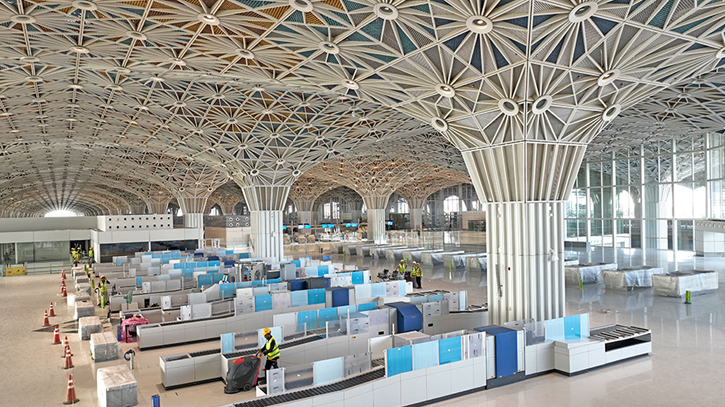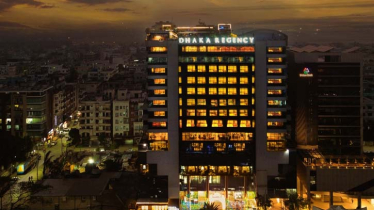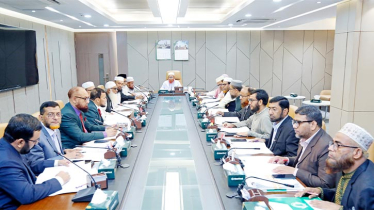
Photo: Collected
The ongoing installation of the new radar system at Hazrat Shahjalal International Airport has already started to show benefits, even though its full capabilities won't be realised for another 6 to 7 months. Currently, the radar covers a surveillance area of 280 nautical miles, significantly enhancing the airport's monitoring capabilities.
This modern radar tower, costing approximately 7.5 billion taka, is expected to substantially increase the revenue of the Civil Aviation Authority of Bangladesh (CAAB). Previously, CAAB's revenue ranged between Tk1500 to 1800 crores, but with the new radar, it anticipates revenues to rise to around Tk3000 crores.
Air Commodore Ziaul Haque, Air Traffic Management (ATM) Member, stated, "We are currently operational with the new radar system, having decommissioned the old one three months ago. Additional works related to the automation of the new radar project are ongoing. We are scheduled for full handover by next February. In case of any delays, it might extend by another three months."
He mentioned that despite the previous radar being outdated, they managed operations with other systems. Flights predominantly traverse Bangladeshi airspace from both directions, with India and Myanmar also utilising this airspace before and after. Notifications are received from these countries when flights pass through without landing at Shahjalal, and pilots also communicate directly with Bangladeshi air traffic control for safety.
He highlighted that previously, they relied on these communications for awareness, but with the new radar, they can now independently track flights without relying solely on notifications.
Responding to inquiries, he disclosed that approximately 50 flights per day utilise Bangladeshi airspace, while the radar can currently track about 60 flights. He emphasised that the introduction of the new and advanced radar system for airspace surveillance is part of Prime Minister Sheikh Hasina's ongoing development initiatives for the country.
CAAB sources have indicated that due to the outdated 44-year-old radar and navigation system, a significant portion of Bangladesh's airspace, as well as the Bay of Bengal, were not effectively monitored. This limitation prevented the country from fully collecting overflying fees, which are approximately 500 dollars per use of the airspace. The outdated system also posed financial losses and security risks.
The radar installation project at Hazrat Shahjalal International Airport, aimed at monitoring the country's skies, is nearing completion. Concurrently, work on the ATC Tower and Operations Building is also reaching its final stages. Despite these advancements, the full deployment and operationalisation of the new radar system will require additional time.
Currently, the new radar system has expanded surveillance to cover the entire airspace of Bangladesh and extends into the vast expanse of the Bay of Bengal beyond the country's borders. The remaining tasks include completing ancillary automation works, which are expected to be finished by the end of the year.
Aronas, the local representative of the project, has stated that the remaining work on the radar installation project will be completed, and the system will be officially inaugurated by November of this year. The project, which has garnered much attention, carries a price tag of approximately 730 crore taka, fully financed by CAAB using its own resources.
The introduction of this state-of-the-art radar system has significantly enhanced flight safety and enabled comprehensive surveillance of the entire airspace of Bangladesh. This capability allows Bangladesh to collect fees from aircraft using its airspace without landing, thereby benefiting the country financially.
Once fully operational, the radar system will ensure that the skies over Bangladesh are effectively monitored, mitigating security risks and enhancing the efficiency of air traffic management.
According to CAAB sources, the overflying income has touched Tk 2000 crores in the last nine financial years, but it has not been completed. It was limited to between Tk1500 to 1800 crore, due to the installation of new radar, the income will stand at 250 to 3000 crore taka. In the financial year 2023-24, the over-flying income was around Tk 1900 crores while it was Tk1700 crores in the financial year 2022-23, Tk1,400 crores in the financial year 2021-22 i.e. during the Corona period. Tk1,500 crores in the financial year 2019-20. Over Tk1,700 crores in the financial year 2018-19, Tk1,600 crores for the fiscal year 2017-18. In the financial year 2016-17, the revenue of the organisation was 1 thousand 559 crore 90 lakhs. In the financial year 2015-16, the income was 1 thousand 330 crore 7 lakh taka. In the financial year 2014-15, the income was 1 thousand 220 crore 80 lakhs.
It is reported that Prime Minister Sheikh Hasina personally intervened to resolve the debate surrounding the initial radar installation costs. She engaged directly with the French President and decided to adopt the G2G system for the project. Subsequently, in April 2021, the government approved the CNS-ATM (Communication, Navigation and Surveillance - Air Traffic Management) radar installation project at Hazrat Shahjalal International Airport.
The Cabinet Committee on Procurement endorsed this project, which includes modernising communication, navigation, surveillance, and air traffic management at CAAB, on June 8, 2021. The estimated cost for this comprehensive upgrade is approximately 730 crore taka.
The expenditure for this project is being funded entirely by CAAB's own resources. In October 2021, CAAB entered into an agreement with Thales, a renowned French radar manufacturer, to execute the radar installation project. According to the contract terms, the radar installation is scheduled to be completed within the next three years. As part of the agreement, Thales has also organised training sessions for CAAB officers to ensure they are proficient in operating this advanced radar system.
Messenger/Disha








